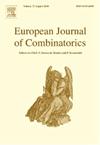谱曼特尔定理的一个改进
IF 0.9
3区 数学
Q1 MATHEMATICS
引用次数: 0
摘要
众所周知的曼特尔定理表明,对于每一个n顶点的无三角形图G, e(G)≤⌊n2/4⌋。1970年,Nosal展示了曼特尔定理的谱版,表明ρ(G)≤m,对于每一个有m条边的无三角形图G。后来,Nikiforov证明了当且仅当G是完全二部图时,这个等式在Nosal界中成立。林,宁,吴[组合]。Probab。[computer . 30(2021)]第一次给出了非二部无三角形图的结果。他们证明了ρ(G)≤m−1,当且仅当G是5环时等式成立。他们的结果实际上比曼特尔定理更有力。最近,李,冯和彭[电子]。J. Combin. 31(2024)]刻画了偶数m的具有最大谱半径的非二部无三角形极值图。进而,他们提出了一个问题:在所有大小为偶数m的非二部{C3,C5,…,C2 r +1}的无三角形图上具有最大谱半径的极值图是什么?本文彻底解决了这个问题。这里我们使用另一种技术,我们称之为残差函数,它可以对相关问题给出更简洁的证明。最后,提出了一个一般性问题,供进一步研究。本文章由计算机程序翻译,如有差异,请以英文原文为准。
A refinement on spectral Mantel’s theorem
The well-known Mantel’s theorem states that for every -vertex triangle-free graph . In 1970, Nosal showed a spectral version of Mantel’s theorem, which states that for every triangle-free graph on edges. Later, Nikiforov proved that the equality holds in Nosal’s bound if and only if is a complete bipartite graph. Lin, Ning, and Wu [Combin. Probab. Comput. 30 (2021)] first gave a result on non-bipartite triangle-free graphs. They proved that , and equality holds if and only if is a 5-cycle. Their result is actually stronger than Mantel’s theorem. Recently, Li, Feng and Peng [Electron. J. Combin. 31 (2024)] characterized the extremal non-bipartite triangle-free graphs with maximal spectral radius for even . Furthermore, they proposed a question as follows: what is the extremal graph with maximal spectral radius over all non-bipartite -free graphs of even size ? This question is completely solved in this paper. Here we use a different technique, and we call it residual function, which can present more concise proofs on related problems. Finally, a general question is proposed for further research.
求助全文
通过发布文献求助,成功后即可免费获取论文全文。
去求助
来源期刊
CiteScore
2.10
自引率
10.00%
发文量
124
审稿时长
4-8 weeks
期刊介绍:
The European Journal of Combinatorics is a high standard, international, bimonthly journal of pure mathematics, specializing in theories arising from combinatorial problems. The journal is primarily open to papers dealing with mathematical structures within combinatorics and/or establishing direct links between combinatorics and other branches of mathematics and the theories of computing. The journal includes full-length research papers on important topics.

 求助内容:
求助内容: 应助结果提醒方式:
应助结果提醒方式:


